 Which font is this one here? Try your luck with this multiple choice Font Game. [The answer to the left is “Hoefler Text.”]
Which font is this one here? Try your luck with this multiple choice Font Game. [The answer to the left is “Hoefler Text.”]
 Which font is this one here? Try your luck with this multiple choice Font Game. [The answer to the left is “Hoefler Text.”]
Which font is this one here? Try your luck with this multiple choice Font Game. [The answer to the left is “Hoefler Text.”]
| I’m a sucker for almost anything printed letterpress, especially if it isn’t the usual card or wedding invitation. Pictured to the right, to quote the seller, d.Sharp, is a “functional belt of letterpress printed paper and quality ribbon to decorate gifts. Forget impossible knots or fussy bows, simply slide over box and cinch, cut excess ribbon as desired. Reusable!” | 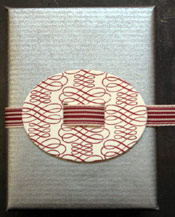 |
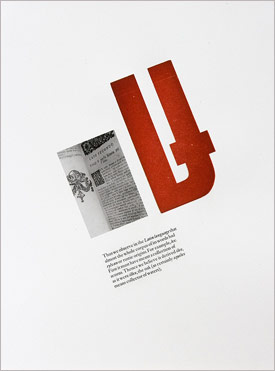 For many years, Jack Stauffacher, a well-known letterpress printer and book-designer at Greenwood Press in San Francisco, has been making broadsides and prints using his small collection of assorted pieces of large wood type. Several prints he did with Dennis Letbetter for an edition in 2006 have recently been on display at San Francisco Center for the Book. In the text for the exhibit there’s a quote by Stauffacher that sums up perfectly how I feel about creating my own wood type collage prints.
For many years, Jack Stauffacher, a well-known letterpress printer and book-designer at Greenwood Press in San Francisco, has been making broadsides and prints using his small collection of assorted pieces of large wood type. Several prints he did with Dennis Letbetter for an edition in 2006 have recently been on display at San Francisco Center for the Book. In the text for the exhibit there’s a quote by Stauffacher that sums up perfectly how I feel about creating my own wood type collage prints.
“Taking these shapes, these letters, they are somehow no longer letters in the formal sense, they become more of a shape, an abstraction, and I have used them [within the page size] allotted to the portfolios in a variety of arrangements, different colors, different connections with the text and the photographs. When you work this closely on the press, you don’t have it all figured out, you do the whole thing mostly right there in the process.”
More on Stauffacher and his wood type work are here. You can see all the prints in the Vico Duodecimo portfolio, one of which is pictured above, here.
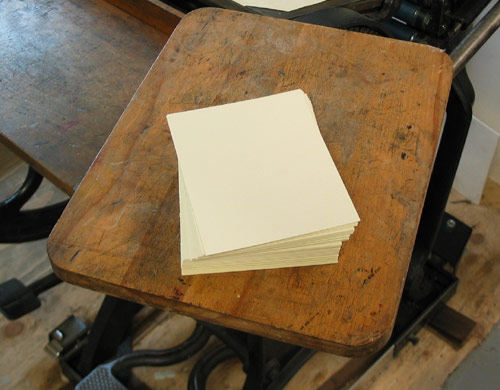
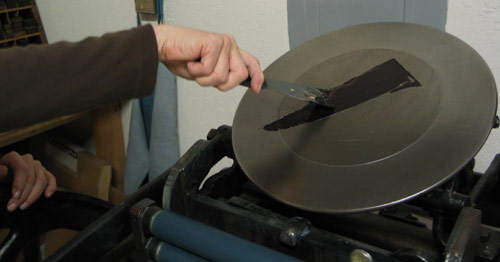
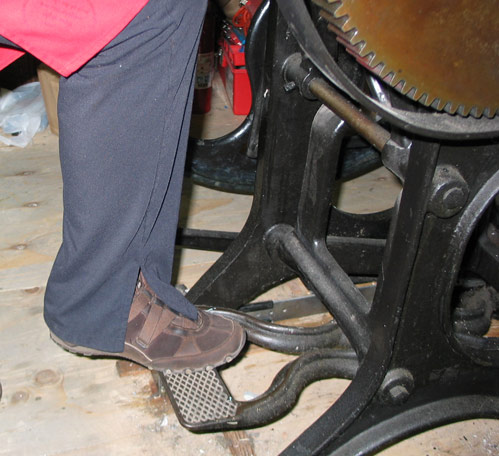
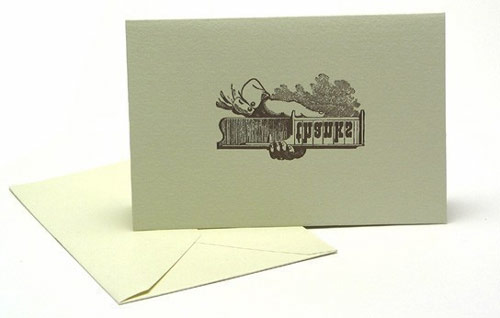
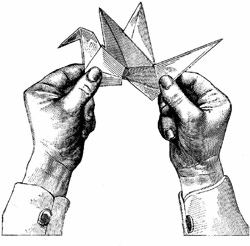 For an upcoming issue of Ampersand (a quarterly journal I edit), I’ve asked half a dozen book artists to comment on the role of craft in their work. This article grew out of the exhibit New West Coast Design at the San Francisco Center for the Book that emphasised the technical expertise required in creating artists’ books.
For an upcoming issue of Ampersand (a quarterly journal I edit), I’ve asked half a dozen book artists to comment on the role of craft in their work. This article grew out of the exhibit New West Coast Design at the San Francisco Center for the Book that emphasised the technical expertise required in creating artists’ books.
![]() This past weekend, as I set about to write an introduction to the article, I thought about what craft means for me. First I hit the dictionary: Craft: an art, trade, or occupation requiring special skill, especially manual skill. It’s a very old word — the dictionary dates its origin to before 900 AD. Today the emphasis seems to be on the manual skill part of the definition, arising from the Arts and Crafts movement of the late 19th century, a style that was a reaction to the “soulless” machine-made production of the Industrial Revolution. For book artists, the wide range of skills involved in making a book can be daunting: a handmade book might include paper making, typography, a range of illustration and printmaking techniques, calligraphy, not to mention those of bookbinding itself.
This past weekend, as I set about to write an introduction to the article, I thought about what craft means for me. First I hit the dictionary: Craft: an art, trade, or occupation requiring special skill, especially manual skill. It’s a very old word — the dictionary dates its origin to before 900 AD. Today the emphasis seems to be on the manual skill part of the definition, arising from the Arts and Crafts movement of the late 19th century, a style that was a reaction to the “soulless” machine-made production of the Industrial Revolution. For book artists, the wide range of skills involved in making a book can be daunting: a handmade book might include paper making, typography, a range of illustration and printmaking techniques, calligraphy, not to mention those of bookbinding itself.
![]() In my ramble through my bookshelf and on the internet, I found 2 quotes about craftsmanship that I especially like. The first is from the curators’ statement for the exhibit at SFCB. It’s by Leonard Koren, from 13 Books (notes on the design, construction & marketing of my last . . . ) Stone Bridge Press, Berkeley, California, 2001
In my ramble through my bookshelf and on the internet, I found 2 quotes about craftsmanship that I especially like. The first is from the curators’ statement for the exhibit at SFCB. It’s by Leonard Koren, from 13 Books (notes on the design, construction & marketing of my last . . . ) Stone Bridge Press, Berkeley, California, 2001
“I want to present . . . as perfect an object as I can. What it could have been, or should have been, is irrelevant. As the creator, I have the ultimate responsibility to make sure my books are produced according to my conception. . . . The problem with bad craftsmanship is that it needlessly distracts from the purity of your communication; it draws away energy and attention; it raises more questions in the reader’s mind that shouldn’t be there.”
The other, by way of my friend Cathy, is from David Pye’s book The Nature and Art of Workmanship, Cambridge University Press, 1968
“If I must ascribe a meaning to the word craftsmanship, I shall say as a first approximation that it means simply workmanship using any kind of technique or apparatus, in which the quality of the result is not predetermined, but depends on the judgement, dexterity and care which the maker exercises as he works. The essential idea is that the quality of the result is continually at risk during the process of making; and so I shall call this kind of workmanship ‘The workmanship of risk’: an uncouth phrase, but at least descriptive.”
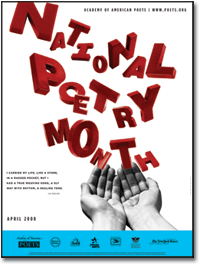 Every year in April, in honor of National Poetry Month, I pull A Poem A Day from my bookshelf. It has 366 poems, organized seasonally, that are mostly short and, according to the anthologists, examples of poetry that is worth memorizing. One editor says “To memorize a poem is much more than a mental exercise. Indeed, it is the only way to truly know a poem.” I’m not particularly good at memorizing entire poems — or songs or movie dialogue for that matter — I know lots of first lines, but never get much further. So every April I open the book and wonder if this year will be different and I’ll memorize one of them. Probably not, but I always enjoy reading one or two before I go to sleep each night. Here’s last night’s selection:
Every year in April, in honor of National Poetry Month, I pull A Poem A Day from my bookshelf. It has 366 poems, organized seasonally, that are mostly short and, according to the anthologists, examples of poetry that is worth memorizing. One editor says “To memorize a poem is much more than a mental exercise. Indeed, it is the only way to truly know a poem.” I’m not particularly good at memorizing entire poems — or songs or movie dialogue for that matter — I know lots of first lines, but never get much further. So every April I open the book and wonder if this year will be different and I’ll memorize one of them. Probably not, but I always enjoy reading one or two before I go to sleep each night. Here’s last night’s selection:
To Daffodils
by Robert Herrick (1591-1674)
Fair Daffodils, we weep to see
You haste away so soon;
As yet the early-rising sun
Has not attain’d his noon.
Stay, stay,
Until the hasting day
Has run
But to the even-song;
And, having pray’d together, we
Will go with you along.
We have short time to stay, as you,
We have as short a spring;
As quick a growth to meet decay,
As you, or anything.
We die
As your hours do, and dry
Away,
Like to the summer’s rain;
Or as the pearls of morning’s dew,
Ne’er to be found again.